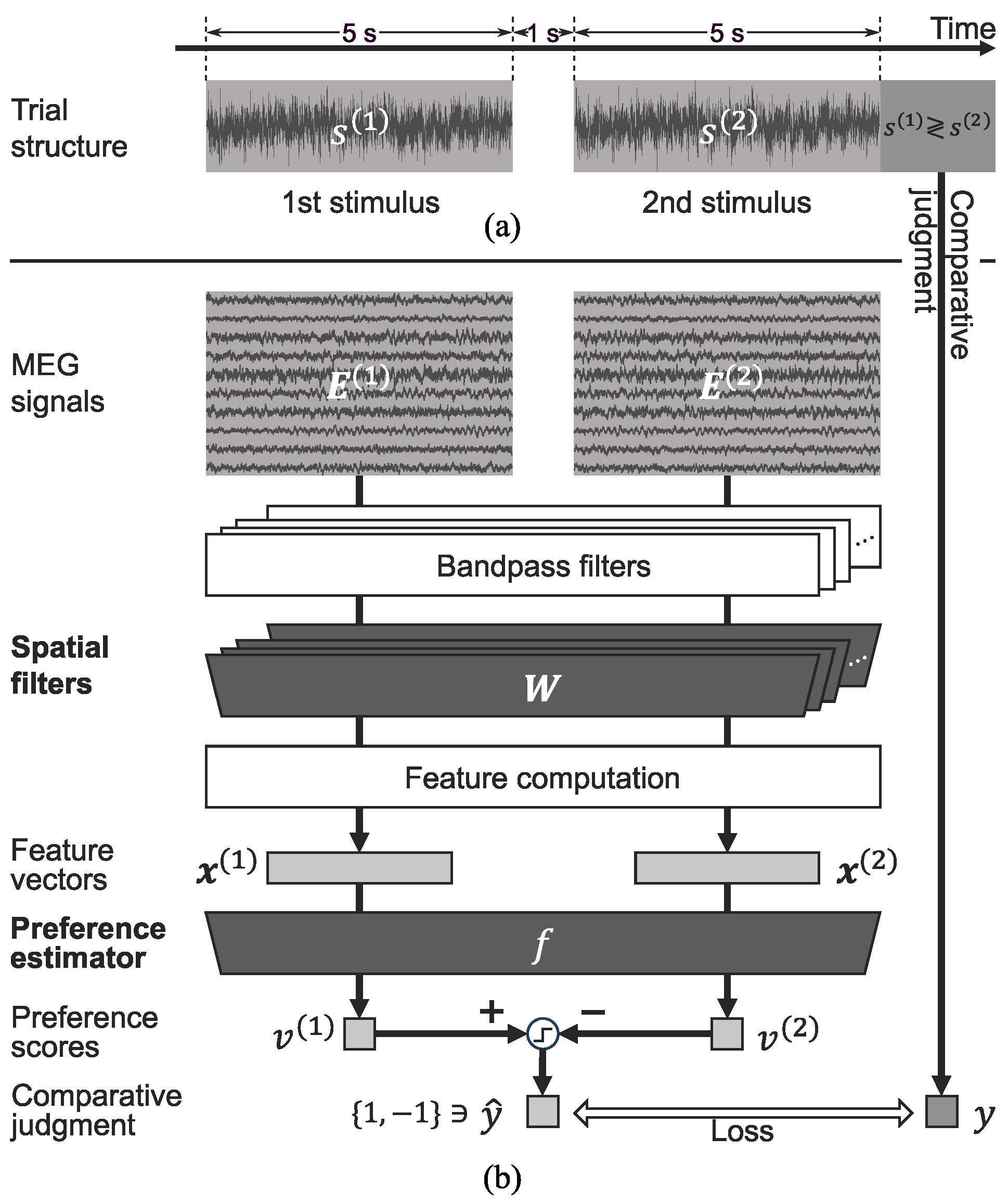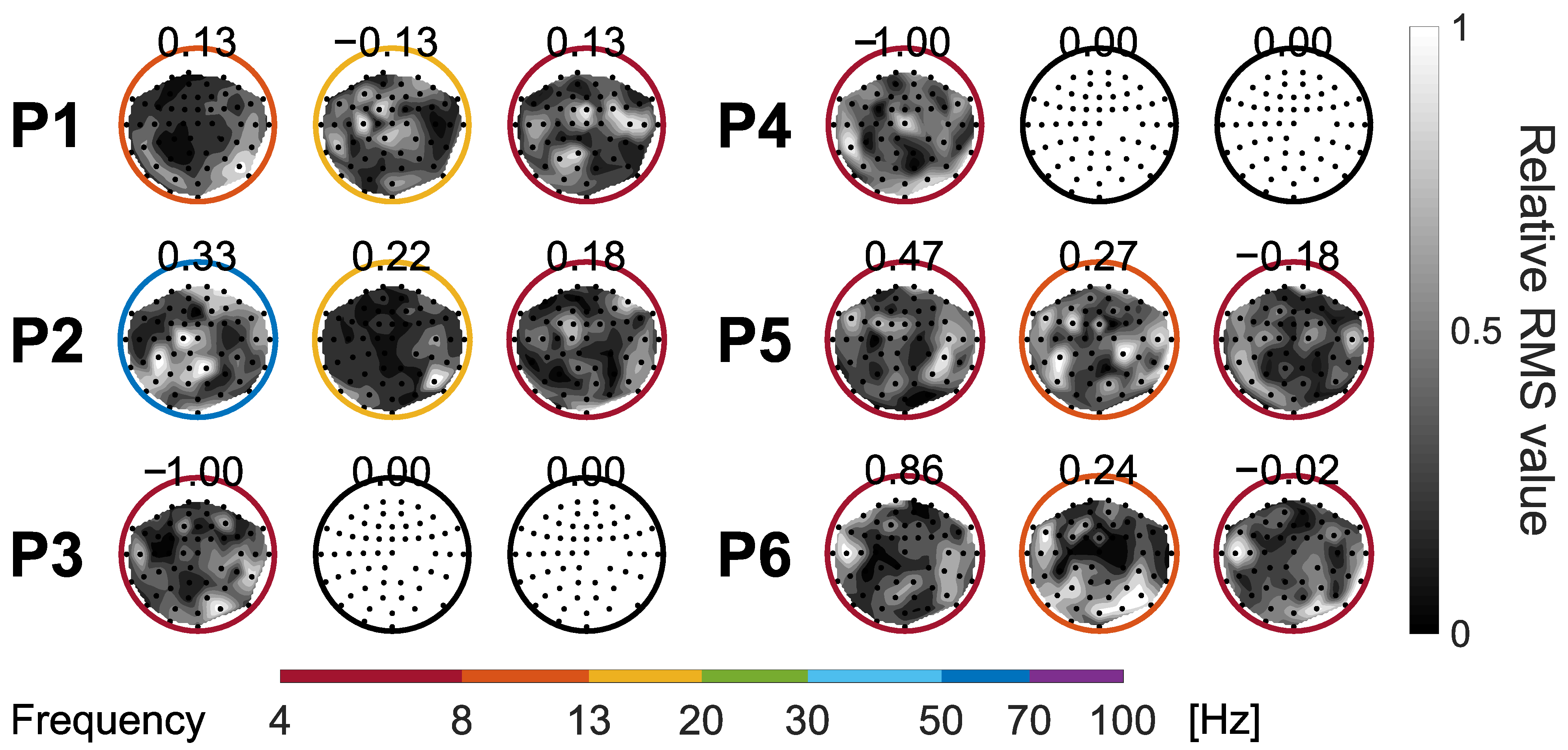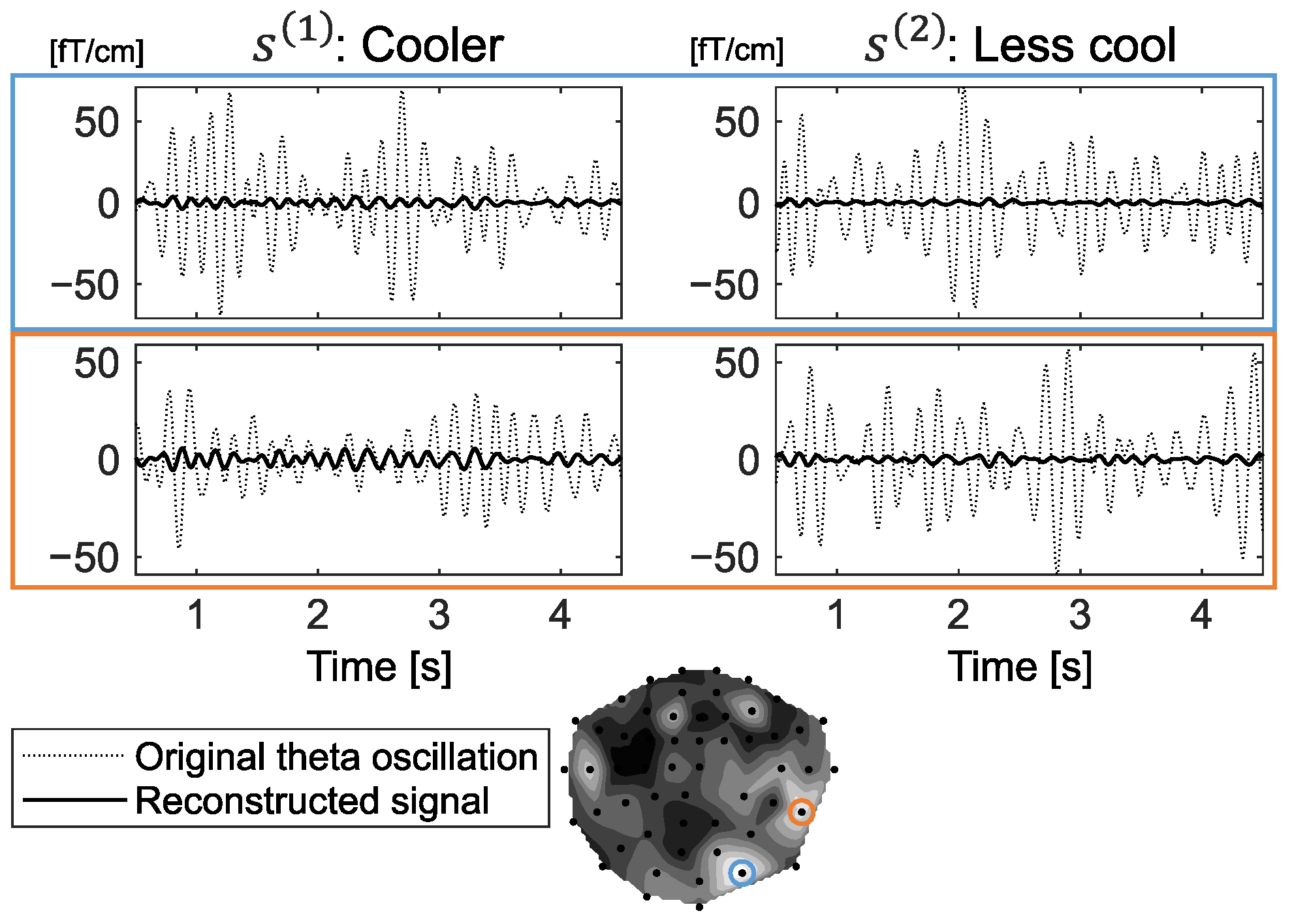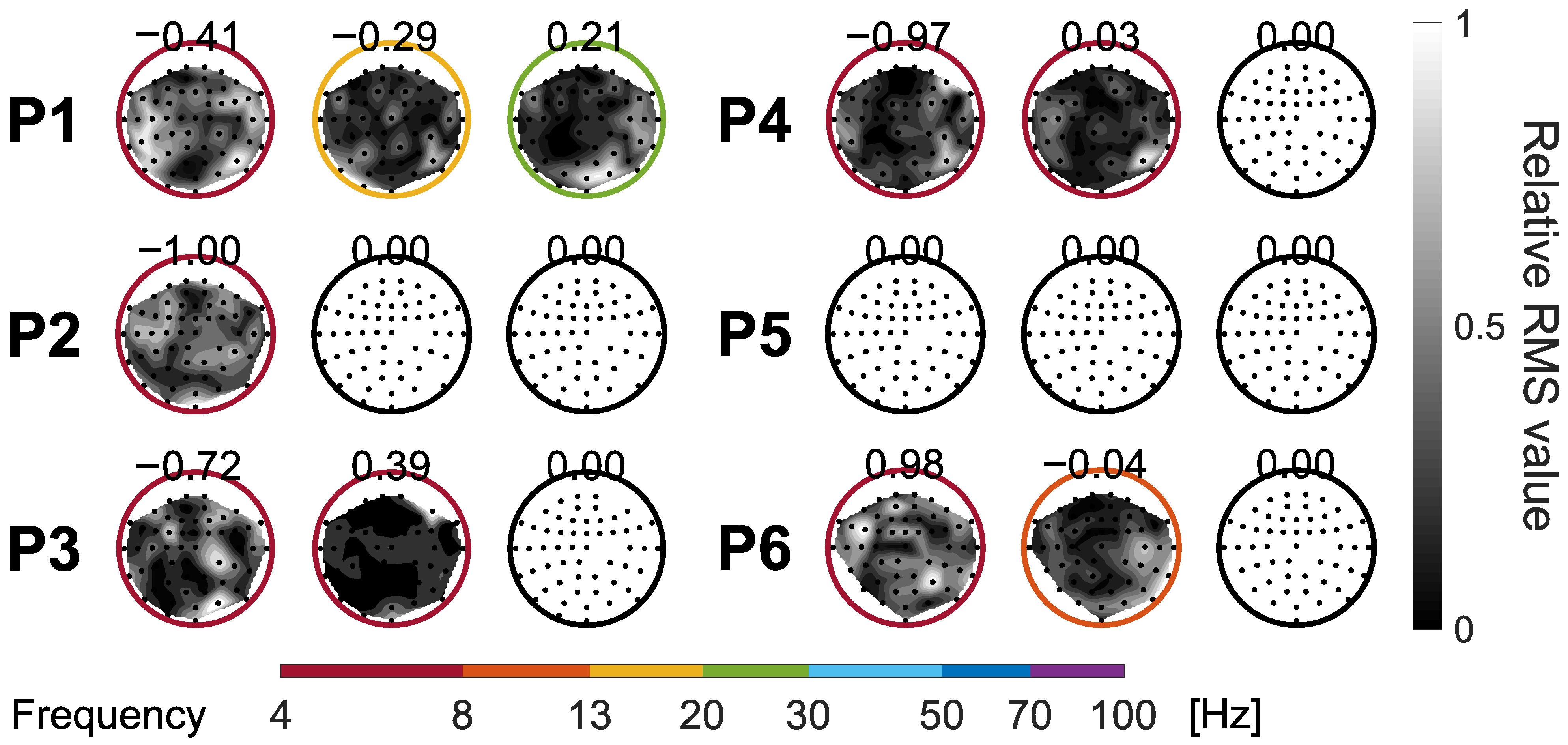Estimation of HVAC Sound Preferences from Cortical Magnetic Patterns During Paired-Comparison Tasks
Abstract
1. Introduction
2. Materials and Methods
2.1. MEG Data
2.1.1. Dataset Description
2.1.2. Data Preprocessing
2.2. Preference Estimation Model
2.3. Feature Extraction from Cortical Signals Associated with Preferences
2.3.1. Common Spatial Pattern
2.3.2. Extraction of Cortical Signals Associated with Preferences
2.3.3. Preference-Based Covariance Matrix Weighting
2.3.4. Mitigation of Presentation Order Effects
2.3.5. Feature Computation
3. Results
3.1. Evaluation Experiment
3.2. Comparative Judgment Prediction
3.3. Estimated Preference Scores
3.4. Magnetic Cortical Patterns Associated with Preferences
3.5. Cross-Participant Evaluation
4. Discussion
4.1. MEG Feature Extraction Associated with HVAC Sound Preferences
4.2. Neurophysiological Estimation of HVAC Sound Preferences
4.3. Cortical Activities Associated with HVAC Coolness and Preference
4.4. Generalizability of Preference Estimation Models to Unseen Participants
4.5. Limitations and Future Directions
5. Conclusions
Author Contributions
Funding
Institutional Review Board Statement
Informed Consent Statement
Data Availability Statement
Conflicts of Interest
Appendix A. Prior Subjective Assessments of HVAC Sounds
Appendix B. Estimated Preference Scores for All Participants


References
- Soeta, Y.; Nakagawa, S.; Tonoike, M.; Ando, Y. Magnetoencephalographic responses corresponding to individual subjective preference of sound fields. J. Sound Vib. 2002, 258, 419–428. [Google Scholar] [CrossRef]
- Lin, Y.P.; Wang, C.H.; Jung, T.P.; Wu, T.L.; Jeng, S.K.; Duann, J.R.; Chen, J.H. EEG-based emotion recognition in music listening. IEEE Trans. Biomed. Eng. 2010, 57, 1798–1806. [Google Scholar] [CrossRef] [PubMed]
- Lee, Y.J.; Shin, T.J.; Lee, S.K. Sound quality analysis of a passenger car based on electroencephalography. J. Mech. Sci. Technol. 2013, 27, 319–325. [Google Scholar] [CrossRef]
- Park, K.H.; Kim, H.J.; Oh, B.; Seo, M.; Lee, E.; Ha, J. Evaluation of human electroencephalogram change for sensory effects of fragrance. Skin Res. Technol. 2019, 25, 526–531. [Google Scholar] [CrossRef]
- Peng, Y.; Lin, Y.; Fan, C.; Xu, Q.; Xu, D.; Yi, S.; Zhang, H.; Wang, K. Passenger overall comfort in high-speed railway environments based on EEG: Assessment and degradation mechanism. Build. Environ. 2022, 210, 108711. [Google Scholar] [CrossRef]
- Wang, F.; Ma, X.; Cheng, D.; Gao, L.; Yao, C.; Lin, W. Electroencephalography as an objective method for assessing subjective emotions during the application of cream. Skin Res. Technol. 2024, 30, e13692. [Google Scholar] [CrossRef]
- Leite, R.P.; Paul, S.; Gerges, S.N. A sound quality-based investigation of the HVAC system noise of an automobile model. Appl. Acoust. 2009, 70, 636–645. [Google Scholar] [CrossRef]
- Tang, S.; Wong, M. On noise indices for domestic air conditioners. J. Sound Vib. 2004, 274, 1–12. [Google Scholar] [CrossRef]
- Susini, P.; McAdams, S.; Winsberg, S.; Perry, I.; Vieillard, S.; Rodet, X. Characterizing the sound quality of air-conditioning noise. Appl. Acoust. 2004, 65, 763–790. [Google Scholar] [CrossRef]
- Park, S.G.; Sim, H.J.; Yoon, J.H.; Jeong, J.E.; Choi, B.J.; Oh, J.E. Analysis of the HVAC system’s sound quality using the design of experiments. J. Mech. Sci. Technol. 2009, 23, 2801–2806. [Google Scholar] [CrossRef]
- Nakagawa, S.; Hotehama, T.; Kamiya, M. Assessment of auditory impression of the coolness and warmness of automotive HVAC noise. In Proceedings of the 39th Annual International Conference of the IEEE Engineering in Medicine and Biology Society (EMBC), Jeju, Republic of Korea, 11–15 July 2017; pp. 4171–4174. [Google Scholar] [CrossRef]
- Back, J.; Lee, S.K.; Min Lee, S.; An, K.; Kwon, D.H.; Park, D.C. Design and implementation of comfort-quality HVAC sound inside a vehicle cabin. Appl. Acoust. 2021, 177, 107940. [Google Scholar] [CrossRef]
- Yano, H.; Takiguchi, T.; Nakagawa, S. Magnetic cortical oscillations associated with subjective auditory coolness during paired comparison of time-varying HVAC sounds. NeuroReport 2024, 35, 1–8. [Google Scholar] [CrossRef] [PubMed]
- Kanosue, K.; Sadato, N.; Okada, T.; Yoda, T.; Nakai, S.; Yoshida, K.; Hosono, T.; Nagashima, K.; Yagishita, T.; Inoue, O.; et al. Brain activation during whole body cooling in humans studied with functional magnetic resonance imaging. Neurosci. Lett. 2002, 329, 157–160. [Google Scholar] [CrossRef] [PubMed]
- Rolls, E.T.; Grabenhorst, F.; Parris, B.A. Warm pleasant feelings in the brain. NeuroImage 2008, 41, 1504–1513. [Google Scholar] [CrossRef] [PubMed]
- Farrell, M.J.; Johnson, J.; McAllen, R.; Zamarripa, F.; Denton, D.A.; Fox, P.T.; Egan, G.F. Brain activation associated with ratings of the hedonic component of thermal sensation during whole-body warming and cooling. J. Therm. Biol. 2011, 36, 57–63. [Google Scholar] [CrossRef]
- Aizawa, Y.; Harada, T.; Nakata, H.; Tsunakawa, M.; Sadato, N.; Nagashima, K. Assessment of brain mechanisms involved in the processes of thermal sensation, pleasantness/unpleasantness, and evaluation. IBRO Rep. 2019, 6, 54–63. [Google Scholar] [CrossRef]
- Yao, Y.; Lian, Z.; Liu, W.; Jiang, C.; Liu, Y.; Lu, H. Heart rate variation and electroencephalograph—The potential physiological factors for thermal comfort study. Indoor Air 2009, 19, 93–101. [Google Scholar] [CrossRef]
- Shan, X.; Yang, E.H.; Zhou, J.; Chang, V.W.C. Human-building interaction under various indoor temperatures through neural-signal electroencephalogram (EEG) methods. Build. Environ. 2018, 129, 46–53. [Google Scholar] [CrossRef]
- Son, Y.J.; Chun, C. Research on electroencephalogram to measure thermal pleasure in thermal alliesthesia in temperature step-change environment. Indoor Air 2018, 28, 916–923. [Google Scholar] [CrossRef]
- Wu, M.; Li, H.; Qi, H. Using electroencephalogram to continuously discriminate feelings of personal thermal comfort between uncomfortably hot and comfortable environments. Indoor Air 2020, 30, 534–543. [Google Scholar] [CrossRef]
- Hadjidimitriou, S.K.; Hadjileontiadis, L.J. Toward an EEG-based recognition of music liking using time-frequency analysis. IEEE Trans. Biomed. Eng. 2012, 59, 3498–3510. [Google Scholar] [CrossRef]
- Atkinson, J.; Campos, D. Improving BCI-based emotion recognition by combining EEG feature selection and kernel classifiers. Expert Syst. Appl. 2016, 47, 35–41. [Google Scholar] [CrossRef]
- Naser, D.S.; Saha, G. Influence of music liking on EEG based emotion recognition. Biomed. Signal Process. Control 2021, 64, 102251. [Google Scholar] [CrossRef]
- Zhong, P.; Wang, D.; Miao, C. EEG-based emotion recognition using regularized graph neural networks. IEEE Trans. Affect. Comput. 2022, 13, 1290–1301. [Google Scholar] [CrossRef]
- Yano, H.; Takiguchi, T.; Nakagawa, S. Cortical patterns for prediction of subjective preference induced by chords. In Proceedings of the 41st Annual International Conference of the IEEE Engineering in Medicine and Biology Society (EMBC), Berlin, Germany, 23–27 July 2019; pp. 5168–5171. [Google Scholar] [CrossRef]
- Hämäläinen, M.; Hari, R.; Ilmoniemi, R.J.; Knuutila, J.; Lounasmaa, O.V. Magnetoencephalography—Theory, instrumentation, and applications to noninvasive studies of the working human brain. Rev. Mod. Phys. 1993, 65, 413–497. [Google Scholar] [CrossRef]
- Hyvärinen, A. Fast and robust fixed-point algorithms for independent component analysis. IEEE Trans. Neural Netw. 1999, 10, 626–634. [Google Scholar] [CrossRef]
- Herbirch, R.; Graepel, T.; Bollmann-Sdorra, P.; Obermayer, K. Learning preference relations for information retrieval. In Proceedings of the AAAI-98 Workshop on Learning for Text Categorization, Madison, WI, USA, 26–27 July 1998; pp. 83–86. [Google Scholar]
- Hüllermeier, E.; Fürnkranz, J.; Cheng, W.; Brinker, K. Label ranking by learning pairwise preferences. Artif. Intell. 2008, 172, 1897–1916. [Google Scholar] [CrossRef]
- Müller-Gerking, J.; Pfurtscheller, G.; Flyvbjerg, H. Designing optimal spatial filters for single-trial EEG classification in a movement task. Clin. Neurophysiol. 1999, 110, 787–798. [Google Scholar] [CrossRef]
- Ramoser, H.; Müller-Gerking, J.; Pfurtscheller, G. Optimal spatial filtering of single trial EEG during imagined hand movement. IEEE Trans. Rehabil. Eng. 2000, 8, 441–446. [Google Scholar] [CrossRef]
- Blankertz, B.; Tomioka, R.; Lemm, S.; Kawanabe, M.; Müller, K.R. Optimizing spatial filters for robust EEG single-trial analysis. IEEE Signal Process. Mag. 2008, 25, 41–56. [Google Scholar] [CrossRef]
- Borg, I.; Groenen, P.J. Modern Multidimensional Scaling, 2nd ed.; Springer Series in Statistics; Springer: New York, NY, USA, 2005. [Google Scholar] [CrossRef]
- Thurstone, L.L. A law of comparative judgment. Psychol. Rev. 1927, 34, 273–286. [Google Scholar] [CrossRef]
- Gulliksen, H. A least squares solution for paired comparisons with incomplete data. Psychometrika 1956, 21, 125–134. [Google Scholar] [CrossRef]
- Friedman, J.; Hastie, T.; Tibshirani, R. Regularization paths for generalized linear models via coordinate descent. J. Stat. Softw. 2010, 33, 1–22. [Google Scholar] [CrossRef] [PubMed]
- Halme, H.L.; Parkkonen, L. Comparing features for classification of MEG responses to motor imagery. PLoS ONE 2016, 11, e0168766. [Google Scholar] [CrossRef]
- Lawhern, V.J.; Solon, A.J.; Waytowich, N.R.; Gordon, S.M.; Hung, C.P.; Lance, B.J. EEGNet: A compact convolutional neural network for EEG-based brain–computer interfaces. J. Neural Eng. 2018, 15, 056013. [Google Scholar] [CrossRef]
- Zhang, C.; Kim, Y.K.; Eskandarian, A. EEG-inception: An accurate and robust end-to-end neural network for EEG-based motor imagery classification. J. Neural Eng. 2021, 18, 046014. [Google Scholar] [CrossRef]
- He, C.; Liu, J.; Zhu, Y.; Du, W. Data augmentation for deep neural networks model in EEG classification task: A review. Front. Hum. Neurosci. 2021, 15, 765525. [Google Scholar] [CrossRef]
- Rommel, C.; Paillard, J.; Moreau, T.; Gramfort, A. Data augmentation for learning predictive models on EEG: A systematic comparison. J. Neural Eng. 2022, 19, 066020. [Google Scholar] [CrossRef]
- Chang, P.F.; Arendt-Nielsen, L.; Chen, A.C. Comparative cerebral responses to non-painful warm vs. cold stimuli in man: EEG power spectra and coherence. Int. J. Psychophysiol. 2005, 55, 73–83. [Google Scholar] [CrossRef]
- Fardo, F.; Vinding, M.C.; Allen, M.; Jensen, T.S.; Finnerup, N.B. Delta and gamma oscillations in operculo-insular cortex underlie innocuous cold thermosensation. J. Neurophysiol. 2017, 117, 1959–1968. [Google Scholar] [CrossRef]
- Stančák, A.; Mlynář, J.; Poláček, H.; Vrána, J. Source imaging of the cortical 10 Hz oscillations during cooling and warming in humans. NeuroImage 2006, 33, 660–671. [Google Scholar] [CrossRef]
- Aftanas, L.; Golocheikine, S. Human anterior and frontal midline theta and lower alpha reflect emotionally positive state and internalized attention: High-resolution EEG investigation of meditation. Neurosci. Lett. 2001, 310, 57–60. [Google Scholar] [CrossRef]
- Sammler, D.; Grigutsch, M.; Fritz, T.; Koelsch, S. Music and emotion: Electrophysiological correlates of the processing of pleasant and unpleasant music. Psychophysiology 2007, 44, 293–304. [Google Scholar] [CrossRef] [PubMed]
- Ertl, M.; Hildebrandt, M.; Ourina, K.; Leicht, G.; Mulert, C. Emotion regulation by cognitive reappraisal—The role of frontal theta oscillations. NeuroImage 2013, 81, 412–421. [Google Scholar] [CrossRef] [PubMed]
- Zhao, G.; Zhang, Y.; Ge, Y. Frontal EEG asymmetry and middle line power difference in discrete emotions. Front. Behav. Neurosci. 2018, 12, 225. [Google Scholar] [CrossRef] [PubMed]
- Ara, A.; Marco-Pallarés, J. Fronto-temporal theta phase-synchronization underlies music-evoked pleasantness. NeuroImage 2020, 212, 116665. [Google Scholar] [CrossRef]
- Scheffé, H. An analysis of variance for paired comparisons. J. Am. Stat. Assoc. 1952, 47, 381–400. [Google Scholar] [CrossRef]
- Oshima, H.; Koizumi, T.; Tsujiuchi, N. Sensory assessment of loudspeakers considering multiple factors. J. Environ. Eng. 2009, 4, 78–88. [Google Scholar] [CrossRef]






| Feature | Participant | Average | SE | |||||
|---|---|---|---|---|---|---|---|---|
| P1 | P2 | P3 | P4 | P5 | P6 | |||
| CSP | 58.0 | 63.2 | 61.3 | 57.8 | 57.3 | 61.3 | 59.8 | 1.0 |
| + CMW | 60.3 | 65.3 | 60.4 | 58.4 | 52.8 | 64.4 | 60.3 | 1.8 |
| + OEM | 62.1 | 62.0 | 62.1 | 59.0 | 57.5 | 64.1 | 61.1 | 1.0 |
| + CMW + OEM | 63.7 | 60.4 | 57.8 | 59.2 | 58.0 | 64.7 | 60.6 | 1.2 |
| Feature | Participant | Average | SE | |||||
|---|---|---|---|---|---|---|---|---|
| P1 | P2 | P3 | P4 | P5 | P6 | |||
| CSP | 65.4 | 56.3 | 64.6 | 59.5 | 56.9 | 65.5 | 61.4 | 1.8 |
| + CMW | 66.1 | 55.1 | 62.1 | 57.4 | 56.9 | 70.8 | 61.4 | 2.5 |
| + OEM | 65.3 | 54.0 | 61.8 | 64.2 | 55.6 | 64.8 | 61.0 | 2.0 |
| + CMW + OEM | 69.2 | 60.1 | 59.8 | 58.3 | 57.5 | 70.7 | 62.6 | 2.4 |
| Assessment Criterion | Unseen Participant | Average | SE | |||||
|---|---|---|---|---|---|---|---|---|
| P1 | P2 | P3 | P4 | P5 | P6 | |||
| Coolness | 50.0 | 52.1 | 58.1 | 52.8 | 51.3 | 50.7 | 52.5 | 1.2 |
| Preference | 50.3 | 46.2 | 53.5 | 62.2 | 51.3 | 49.3 | 52.1 | 2.2 |
Disclaimer/Publisher’s Note: The statements, opinions and data contained in all publications are solely those of the individual author(s) and contributor(s) and not of MDPI and/or the editor(s). MDPI and/or the editor(s) disclaim responsibility for any injury to people or property resulting from any ideas, methods, instructions or products referred to in the content. |
© 2025 by the authors. Licensee MDPI, Basel, Switzerland. This article is an open access article distributed under the terms and conditions of the Creative Commons Attribution (CC BY) license (https://creativecommons.org/licenses/by/4.0/).
Share and Cite
Yano, H.; Takiguchi, T.; Nakagawa, S. Estimation of HVAC Sound Preferences from Cortical Magnetic Patterns During Paired-Comparison Tasks. Appl. Sci. 2025, 15, 12009. https://doi.org/10.3390/app152212009
Yano H, Takiguchi T, Nakagawa S. Estimation of HVAC Sound Preferences from Cortical Magnetic Patterns During Paired-Comparison Tasks. Applied Sciences. 2025; 15(22):12009. https://doi.org/10.3390/app152212009
Chicago/Turabian StyleYano, Hajime, Tetsuya Takiguchi, and Seiji Nakagawa. 2025. "Estimation of HVAC Sound Preferences from Cortical Magnetic Patterns During Paired-Comparison Tasks" Applied Sciences 15, no. 22: 12009. https://doi.org/10.3390/app152212009
APA StyleYano, H., Takiguchi, T., & Nakagawa, S. (2025). Estimation of HVAC Sound Preferences from Cortical Magnetic Patterns During Paired-Comparison Tasks. Applied Sciences, 15(22), 12009. https://doi.org/10.3390/app152212009







